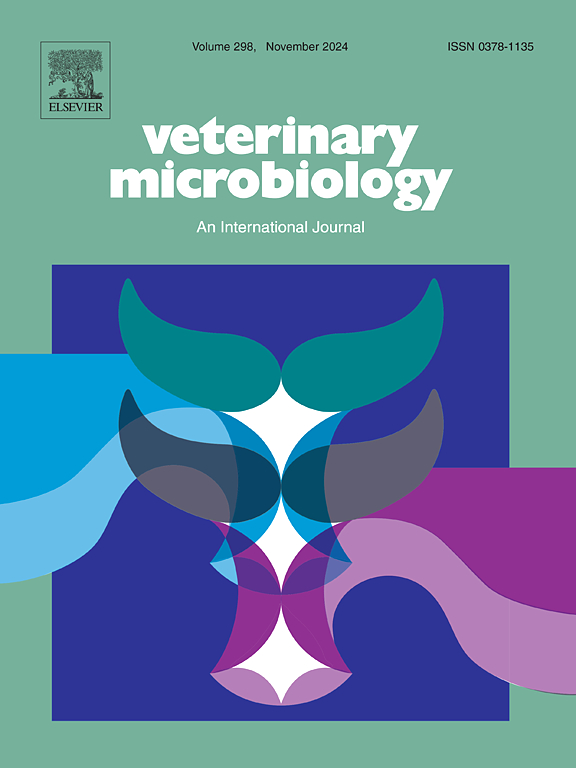禽呼肠孤病毒诱导自噬介导的子代病毒货物进入细胞外囊泡并增强病毒释放
IF 2.4
2区 农林科学
Q3 MICROBIOLOGY
引用次数: 0
摘要
禽呼肠孤病毒(ARV)从宿主细胞释放的机制是由几种途径协调的,其中许多机制尚不清楚。在这里,我们报道外泌体蛋白CD81和CD63的抑制显著降低了病毒的相对释放。我们观察到,随着时间的推移,ARV诱导外泌体蛋白表达,并发现p17蛋白在病毒释放中起关键作用。免疫荧光分析显示,ARV病毒粒子被自噬体包裹,然后被运输到细胞外囊泡释放。用Thapsigargin (TG)、bafilomycin A1或Rab7a shRNA抑制自噬体成熟会破坏与溶酶体的融合,导致病毒释放比和病毒滴度大幅下降。为了进一步确定病毒是否利用自噬将新生病毒转移到外泌体作为避免骨髓基质细胞抗原-2 (BST-2)降解的机制,shRNA耗尽BST-2可增加病毒释放和病毒滴度。用TG抑制自噬体成熟导致病毒蛋白水平和病毒释放降低,证实了自噬体形成在病毒释放中的关键作用。此外,敲低BST-2可适度逆转tg调节的病毒释放抑制。综上所述,本研究对arv诱导的自溶酶体和抑制BST-2增强的子代病毒到细胞外囊泡(ev)释放提供了新的见解。本文章由计算机程序翻译,如有差异,请以英文原文为准。
Avian reovirus induces autophagy-mediated cargo of progeny viruses to extracellular vesicles and enhancement of virus release
The release mechanism of avian reovirus (ARV) from host cells is orchestrated by several pathways and many of these mechanisms remained elusive. Here, we report that inhibition of exosome proteins CD81 and CD63 significantly reduced the relative release of the virus. We observed that ARV induced exosome protein expression over time and found that p17 protein play a pivotal role in virus release. Immunofluorescence assays revealed that ARV virions are coated with autophagosome and are then transported to the extracellular vesicles for release. Suppression of autophagosome maturation with Thapsigargin (TG), bafilomycin A1, or Rab7a shRNA disrupts fusion with lysosomes, resulting in a substantial drop in both the viral release ratio and virus titers. To further identify whether the virus uses autophagy to transfer nascent virus to exosomes as mechanism to avoid degradation caused by bone marrow stromal cell antigen-2 (BST-2), depletion of BST-2 by the shRNA increased virus release and virus titer. Inhibition of autophagosome maturation with TG resulted in a decrease in viral protein levels and virus release, confirming a crucial role of autolysosome formation in virus release. Furthermore, knockdown of BST-2 moderately reversed TG-modulated inhibition of virus release. Taken together, this study provides novel insights into ARV-induced autolysosome and suppression of BST-2 enhancing progeny viruses to extracellular vesicles (EVs) for release.
求助全文
通过发布文献求助,成功后即可免费获取论文全文。
去求助
来源期刊

Veterinary microbiology
农林科学-兽医学
CiteScore
5.90
自引率
6.10%
发文量
221
审稿时长
52 days
期刊介绍:
Veterinary Microbiology is concerned with microbial (bacterial, fungal, viral) diseases of domesticated vertebrate animals (livestock, companion animals, fur-bearing animals, game, poultry, fish) that supply food, other useful products or companionship. In addition, Microbial diseases of wild animals living in captivity, or as members of the feral fauna will also be considered if the infections are of interest because of their interrelation with humans (zoonoses) and/or domestic animals. Studies of antimicrobial resistance are also included, provided that the results represent a substantial advance in knowledge. Authors are strongly encouraged to read - prior to submission - the Editorials (''Scope or cope'' and ''Scope or cope II'') published previously in the journal. The Editors reserve the right to suggest submission to another journal for those papers which they feel would be more appropriate for consideration by that journal.
Original research papers of high quality and novelty on aspects of control, host response, molecular biology, pathogenesis, prevention, and treatment of microbial diseases of animals are published. Papers dealing primarily with immunology, epidemiology, molecular biology and antiviral or microbial agents will only be considered if they demonstrate a clear impact on a disease. Papers focusing solely on diagnostic techniques (such as another PCR protocol or ELISA) will not be published - focus should be on a microorganism and not on a particular technique. Papers only reporting microbial sequences, transcriptomics data, or proteomics data will not be considered unless the results represent a substantial advance in knowledge.
Drug trial papers will be considered if they have general application or significance. Papers on the identification of microorganisms will also be considered, but detailed taxonomic studies do not fall within the scope of the journal. Case reports will not be published, unless they have general application or contain novel aspects. Papers of geographically limited interest, which repeat what had been established elsewhere will not be considered. The readership of the journal is global.
 求助内容:
求助内容: 应助结果提醒方式:
应助结果提醒方式:


